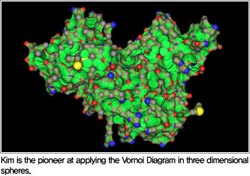

Professor Deok-Soo Kim of the Department of Industrial Engineering is a pioneer in adapting the Voronoi Diagram for 3D Spheres in biological molecules. Prof. Kim is also the creator of BetaMol, a molecular modeling, analyzing, and processing software based on the theory of the Voronoi diagram, quasi-triangulation, and the Beta-complex.
His publications include “Protein Structure Optimization by Side-chain Positioning via Beta-complex” in the Journal of Global Optimization; “BetaMol: a molecular modeling, analysis and visualization software based on the beta-complex and the quasi-triangulation” in the Journal of Advanced Mechanical Design, Systems, and Manufacturing; and “Beta-decomposition for the Volume and Area of the Union of Three-dimensional Balls and Their Offsets” in the Journal of Computational Chemistry.
The Voronoi Diagram is a set of Voronoi regions that are closer to a corresponding object than any other objects. By being able to express the spatial information of particles, it provides an effective and quick solution to geometrical problems.
While the Voronoi Diagram has been researched in two dimensional structures, Kim initiated and succeeded in the field of three dimensional spheres. Throughout the years, Kim’s theories and systems have provided a foundation to analyze the structure of particles with speed and effectiveness. Kim, an industrial engineer, has broadened his interest to the field of molecular biology, in order to solve problems faced in application.
Properly understanding the information of a molecular surface assists in the calculation of the molecule’s energy. This is a common challenge faced by numerous biochemists. Because the task of determining the surface is a geometrical issue, by using the systems developed by Kim, individuals can greatly reduce both time and effort and thus focus on other issues rather than on the geometry. At the moment, Kim’s theory is being used by numerous institutions and individuals.
Docking is important in the area of molecular modeling and is essential for the development of pharmaceutics. While continued research has been conducted by others, noticeable positive results have been generated particularly when using Kim’s method.
Through his method, Kim hopes to design proteins by means of protein modification in the future. While a variety of software exists for protein modification, they are still in their inchoate stage. To enhance and enable the reduction of time and effort with more effectiveness, Kim will attempt to create a new system which is embedded with his own methods.
In addition, Kim is striving to create a new field called ‘Molecular Geometry.’ To overcome the obstacles related to geometrical issues faced by individuals devoted to the study of molecules, Kim’s 'Molecular Geometry' aims at providing geometrical solutions within the spectrum of molecules. Kim has recently conducted a lecture and seminar at the IBM Thomas J. Watson Research Center and New York University's Courant Institute of Mathematical Sciences. One third of the progress needed to create 'Molecular Geometry' has been completed and future research is still necessary. However, Kim believes that the establishment of his proposed new field will have a major impact in a wide range of fields.
Written by Jisoo Lee (themanjsl@hanyang.ac.kr) for Internet Hanyang News












